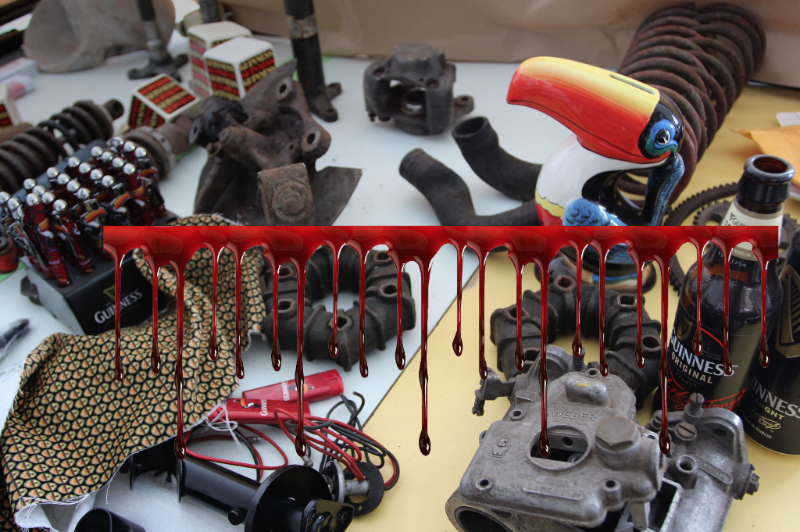James Beckett – The Guinness Curse

La mostra consiste in nuovo gruppo di lavori – una serie di assemblaggi disposti su parete e pavimento con cui l’artista indaga un tema centrale, la strana ed elevata incidenza di morti premature nella famiglia Guinness. Il progetto tocca temi che vanno dalla speculazione, al mito, alla superstizione fino alla stessa cultura pop.
Comunicato stampa
T293 is proud to present The Guinness Curse, James Beckett’s fourth exhibition at the gallery. The exhibition consists of a new body of thematic work - a series of wall and floor assemblages delving into the bizarrely high occurrence of premature death in the Guinness family. The exhibition touches on speculation, myth, superstition and, inevitably, pop culture itself.
In keeping with Beckett’s vocabulary, the works are developed in a macabre museological sphere, using formal artifacts to legitimatize peripheral narrative. The pieces combine biographical elements from each family member portrayed with merchandise from the brewing company itself - a mélange evoking discomfort through clash. Using display grids, additional planes of custom printed fabrics and tinted glass evoke an austerity, making for an environment of fatality - then memorial.
The Guinness family is a large aristocratic Anglo-Irish Protestant dynasty known for its accomplishments in banking, politics, religious ministry, and even fashion. Most notable, is the Guinness brewery business founded by Arthur Guinness in 1759. Arthur fathered 21 children, of whom only 10 survived to maturity. The “Guinness Curse” (hence the name of this show) has been a recurring media phrase referring to this high death rate; deemed ‘pre-destined’ and somehow doomed to be repeated throughout the family history.
Beckett exploits this casual media naming of a metaphysical damning, integrating elements of both company and person into commemorative displays. “The Curse” is, for this purpose, exaggerated to the point of b-grade horror, with abstract clichés of death appearing, for example, in the form of blood streaks amid snippets of raw nature. This approach sees life in its entirety as inapproachable, instead turning to the extended drama of others as a provisional model for alternative celebrity. In this sense, as a study of yearning and loss, the show spawns a shallow and sinister form of entertainment.
Tara Browne would be a good case in point. A Guinness heir, Tara crashed his Lotus Elan into the back of a parked truck, swerving at the last minute and crushing his own body in order to save the life of his passenger, model Suki Potier. This event is said to have inspired the Beatle song A Day in the Life, with these lyrics: He blew his mind out in a car; he hadn’t noticed that the lights had changed. The display commemorating this particular death uses car-parts from the same model vehicle Tara was driving, together with an array of Guinness toucan aprons.
As the dark stout began to travel the world, the level of hops was boosted to insure that it could remain robust whilst passing the equator in shifting temperatures. As a parallel, two family members are chosen for portrayal, for their formative roles in far-flung corners of the globe:
Walter Guinness, (1st Baron Moyne) was assassinated by the marginal Jewish terrorist group Lehi in Cairo in 1944, due to his role as British Minister of State in the Middle East. As a member of the House of Lords, Walter had travelled extensively, - one such trip being to Papua New
Guinea, a journey which resulted in the publication “Walkabout - A Journey in Lands between The Pacific & Indian Oceans”. The pages of this book appear as excerpts in a series of wall pieces.
Preacher, Henry Grattan Guinness was responsible for training and dispatching hundreds of faith missionaries all over the world, including his own daughter. Lucy E. Guinness published “Across India at the Dawn of the 20th Century” about her hopes of converting the so called “heathen natives” to Christianity. Relentless pages of concerned verse, illustrations, and statistics, paint a portrait of a country in dire need of rescue, all perhaps justifying a role for Lucy, had she not prematurely perished of septicemia. Extracts from these pages and occasional photos form the back-drops of such portraits in “The Guinness Curse”.
James Beckett’s work in diverse media examines subjects of a historical nature, from the development (and subsequent demise) of European industry, to the more metaphysical aspects of dowsing and voodoo. The outcomes of these investigations explore the peculiarity of human behaviour, with craft-like assembly placing the work uncomfortably between a bourgeois decorative art and a crude social reality. Recent shows include: 56th Venice Biennale, Belgian Pavilion (IT); Utopia/Dystopia, MAAT (PT), 5th Thessaloniki Biennale (GR); Artspace, Aukland/Physics Room, (NZ). He has published two monographs: “Works of James Beckett with Constant Interjections by Frank Key”, TWAAS/Koenig books (US); “James Beckett”, Kehrer Verlag (DE).
James Beckett
The Guinness Curse
21 marzo – 21 aprile 2017
Inaugurazione 21 marzo 2017, ore 19.00
Via Ripense 6, Rome
[email protected]
T293 è lieta di presentare ‘The Guinness Curse’, la quarta personale di James Beckett in galleria. La mostra consiste in nuovo gruppo di lavori – una serie di assemblaggi disposti su parete e pavimento con cui l’artista indaga un tema centrale, la strana ed elevata incidenza di morti premature nella famiglia Guinness. Il progetto tocca temi che vanno dalla speculazione, al mito, alla superstizione fino alla stessa cultura pop.
In armonia con il vocabolario di Beckett, le opere si sviluppano attraverso una macabra sfera museologica che si serve di elementi formali per legittimare la narrazione. I lavori ritraggono elementi biografici di ciascun membro della famiglia combinandoli con mercanzie del birrificio stesso, un mélange che evoca il dramma attraverso il contrasto. Display a griglia, pannelli rivestiti di stoffa stampata e vetro colorato evocano un’austerità, che si avvicina a uno scenario di fatalità – sino al memoriale.
La famiglia Guinness è una grande dinastia aristocratica anglo-irlandese di fede protestante, nota per i suoi successi nel settore bancario, politico, religioso e persino della moda. L’attività più conosciuta è il birrificio Guinness fondato nel 1759 da Arthur Guinness, padre di 21 figli, di cui solo 10 giunti alla maturità. Quest’alto tasso di mortalità ha portato i media a coniare l’espressione ‘Guinness Curse’ (da qui il nome della mostra), in qualche modo 'predestinata' e destinata a ripetersi in tutta la storia della famiglia.
Beckett si rifà a questa denominazione dei media, unendo all’interno di display commemorativi elementi legati al birrificio e alle persone coinvolte. ‘The Curse’ viene esasperato al punto da apparire una sorta di horror di serie B, con cliché legati alla morte come le strisce di sangue tra pezzi di natura cruda. Quest’approccio rivela la vita nella sua inaccessibilità, rivolgendosi al dramma degli altri come a un modello di celebrazione alternativa. La mostra produce una forma d’intrattenimento superficiale e sinistro, come uno studio sul desiderio e sulla perdita.
Tara Brown, un ereditiero della famiglia Guinness, potrebbe essere un esempio calzante. Egli si è scontrato con un camion parcheggiato, deviando all’ultimo minuto e schiacciando il proprio corpo al fine di salvare la vita della sua passeggera, la modella Suki Potier. Questo evento si pensa abbia ispirato la canzone dei Beatle ‘A Day in the life’, con queste parole: He blew his mind out in a car; he hadn’t noticed that the lights had changed. Il display commemora questa morte utilizzando pezzi della macchina dello stesso modello guidato da Tara insieme a una varietà di grembiuli Guinness che raffigurano un tucano.
Quando la birra al malto ha cominciato a essere esportata nel mondo, il livello del luppolo è stato potenziato per garantire che rimanesse robusto passando per l’equatore ed essendo soggetto a cambiamenti di temperatura. Al tempo stesso due membri della famiglia furono scelti, per il loro ruoli formativi, come rappresentanti in angoli lontani del globo:
Walter Guinness (primo barone Moyne) fu assassinato dal gruppo terrorista Ebreo Lehi al Cairo nel 1944, a causa del suo incarico di Ministro di Stato Britannico in Medio Oriente. Come membro della House of Lords, Walter aveva viaggiato molto. Il suo viaggio iniziò in Papa Nuova Guinea, e lo portò a pubblicare “Walkabout - A Journey in Lands between The Pacific & Indian Oceans”. Le pagine di questo libro compaiono come estratti in una serie di lavori a muro.
Il predicatore Henry Grattan Guinness era responsabile della formazione, in tutto il mondo, di centinaia di missionari di fede, tra cui sua figlia. Lucy E. Guinness pubblicò ‘Across India at the Dawn of the 20th Century’ che narrava le sue speranze di convertire i ‘nativi pagani’ al cristianesimo. Pagine inarrestabili di versi preoccupati, illustrazioni e statistiche che ritraggono una nazione con un disperato bisogno di aiuto, tutto forse per giustificare il ruolo di Lucy che morì prematura di setticemia. Estratti di queste pagine e alcune fotografie formano lo scenario di questi ritratti nella mostra ‘The Guinness Curse’.
James Beckett lavora con diversi media ed esamina soggetti di natura storica, dallo sviluppo (e successiva scomparsa) dell’industria europea, agli aspetti più metafisici della rabdomanzia e del voodoo. I risultati di queste indagini esplorano le peculiarità del comportamento umano, con un assemblaggio manuale che pone il suo lavoro tra l’arte decorativa e la cruda realtà sociale. Le sue mostre recenti includono: 56 Biennale di Venezia, Padiglione del Belgio (IT); Utopia/Dystopia, MAAT (PT), 5 Biennale Thessaloniki (GR); Artspace, Aukland/Physics Room, (NZ). Ha pubblicato due monografie: “Works of James Beckett with Constant Interjections by Frank Key”, TWAAS/Koenig books (US); “James Beckett”, Kehrer Verlag (DE).



